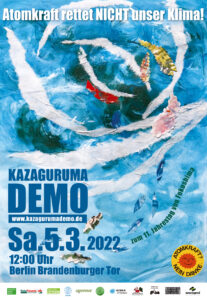Sayonara Nukes Berlin, together with Yosomono-net, a worldwide anti-nuke network of Japanese people living abroad , has issued the following statement of protest against the government’s decision to release of Fukushima nuclear-contaminated water into the ocean.
Fukushima, Japan: Radioactively contaminated water dumped into the Pacific Ocean?
Japan is planning to dump diluted, filtered and still radioactive water from the crippled Fukushima Daiichi (FD) nuclear power plant into the ocean this summer.
What’s happening in Fukushima?
After the massive earthquake and tsunami of March 11, 2011, a major nuclear accident occurred at the FDNPP, resulting in hydrogen explosions and core meltdowns. This resulted in a massive release of radioactive materials into the environment, contaminating air, soil, water, and food on land and sea, and continues to do so today.
More than 12 years later, the nuclear emergency declaration issued at the time remains in place, and more than 20,000 people are officially registered as evacuees. The population of the mandatory evacuation zones of Fukushima are subjected to an annual exposure limit of 20 millisieverts, 20 times the former legal civilian limit. This is the same as the limit for nuclear workers and it also applies to children, young people, and pregnant women.
What is to be discharged into the sea?
The damaged reactors must continue to be cooled with water, although closed cooling circuits have been destroyed. Due to rainwater and groundwater pouring in, the amount of contaminated water is increasing every day. At present, more than 1.3 million tons of contaminated water are stocked in tanks. Japan wants to discharge this water, filtered and diluted, into the sea.
What the Japanese government, IAEA and TEPCO say
The water with radionuclides would be treated with the ALPS filtering system “up to the limit of harmlessness.” Mainly, only the isotope tritium would remain, which cannot be filtered out. All nuclear power plants in the world routinely discharge water containing tritium. All radionuclides contained would be treated to be below the relevant limit, and the water would be heavily diluted before discharge into the sea. The International Atomic Energy Agency (IAEA) has given its blessing to this plan. TEPCO says it would soon run out of space for storage at the site.
What problems and risks the project conceals
The water stored at Fukushima Daiichi is liquid radioactive waste that has come in contact with melted fuel rods and cannot be compared to the tritiated water released during normal reactor operation. It is often said that tritium, an isotope of hydrogen, is the only nuclide that remains after treatment, but in fact, in addition to tritium, the water contains cesium-134 and cesium-137, strontium-90, cobalt-60, carbon-14, and iodine-129 and more.
However, the effect of tritium on the ecosystem and the food chain is far too little studied, and the few existing study results are hardly taken into account. At what quantity may something be assessed as “harmless,” and by whom? For the release of radioactive substances into the environment, Japan has determined the activity concentration limit for each radionuclide, which is supposed to correspond to the concentration of that radionuclide at which the average dose rate of 1 millisievert per year would be reached if one ingested 2 liters of that water daily for 70 years. That means the estimates of long-term effects are not considered. Far too little research has been done on how individual radionuclides behave in seawater, accumulate in the food chain, and what damage they might do. Even if the concentration were diluted, tritium would be discharged into the sea at a total rate of 22 trillion becquerels per year. Whether diluted or dispersed, the amount would remain the same.
The half-life of tritium is 12 years; Strontium 90, 28.8 years; carbon 14, 5730 years and iodine 129, 15.7 million years.
Precautionary and preventive principles
From the point of view of radiation protection, the water at FD must continue to be kept in tanks under strict control. In case of doubt, the principles of precaution and prevention should apply!
One reason for concern is the increase in fish contaminated with cesium 134/137 caught in neighboring ports. In June 2023, a high contamination of 18,000 becquerels per kilo was even measured in a black rockfish. This indicates that an uncontrolled leak of contaminated water is continuing. Without thoroughly investigating and taking measures against this, it would be unethical to discharge contaminated water into the sea.
“Mental decontamination” and “reputational damage”
Instead of protecting the population against delayed health impacts from radiation, the Japanese government prefers to spread a fairy tale. “A little radioactivity is harmless, rather fear is the evil of the problem.” Instead of more accurate health studies and measurements of radioactive contamination, a series of “mental decontamination” campaigns are supposed to combat “psychosomatic” effects. Strong public messages in the form of manipulative advertisements are repeated on a grand scale with one-sided conclusions by pro-nuclear scientists. People’s legitimate fears are dismissed as panic about radiation and demonized as “reputational damage” (against food staples, Fukushima residents and territory) that would prevent the economic growth and reconstruction of Fukushima.
IAEA and the promotion of atomic energy
The task of the IAEA, founded in 1957 following the “Atoms for Peace” program, to promote the civil use of atomic energy, is not “radiation protection.” It sets rules for the extent to which radiation risks should be considered “negligible.” The IAEA Review of Safety Related Aspects does not take into account possible long-term effects on the marine ecosystem. Why should its final report be understood as permission to dump contaminated water into the sea?
Out of sight, out of mind?
Neighboring countries and the South Pacific Island states are right to protest against Japan’s plan. UN experts are also expressing concern about the potential dangers to human health and the environment. If dumping were to begin, it would serve as a precedent for future ocean disposal of contaminated water. In fact, for more than three decades in the future, Japan wants to further pollute the sea, which is connected to all the other seas in the world, and which already suffers greatly from various environmental impacts. The sea is not a waste disposal site. It is irresponsible to spread more contamination instead of isolating it as much as possible. But TEPCO and the Japanese government prefer to cover up the obvious accident consequences, such as numerous contaminated water tanks, by disposing the toxins into the sea. We must never accept this!
Therefore, we demand:
- No discharge of radioactive water into the sea, whether at Fukushima or elsewhere
- Establishment of monitoring and research systems worldwide for all nuclear facilities by independent organizations for monitoring and analysis of ecosystem changes and people’s health impacts
- Transparent communication and publication of research and monitoring results
For the French version of the statement, please visit : https://yosomono-net.jimdofree.com/
Sources:
https://www.pref.fukushima.lg.jp/site/portal-de/de04-02.html
https://www.iaea.org/sites/default/files/iaea_comprehensive_alps_report.pdf












